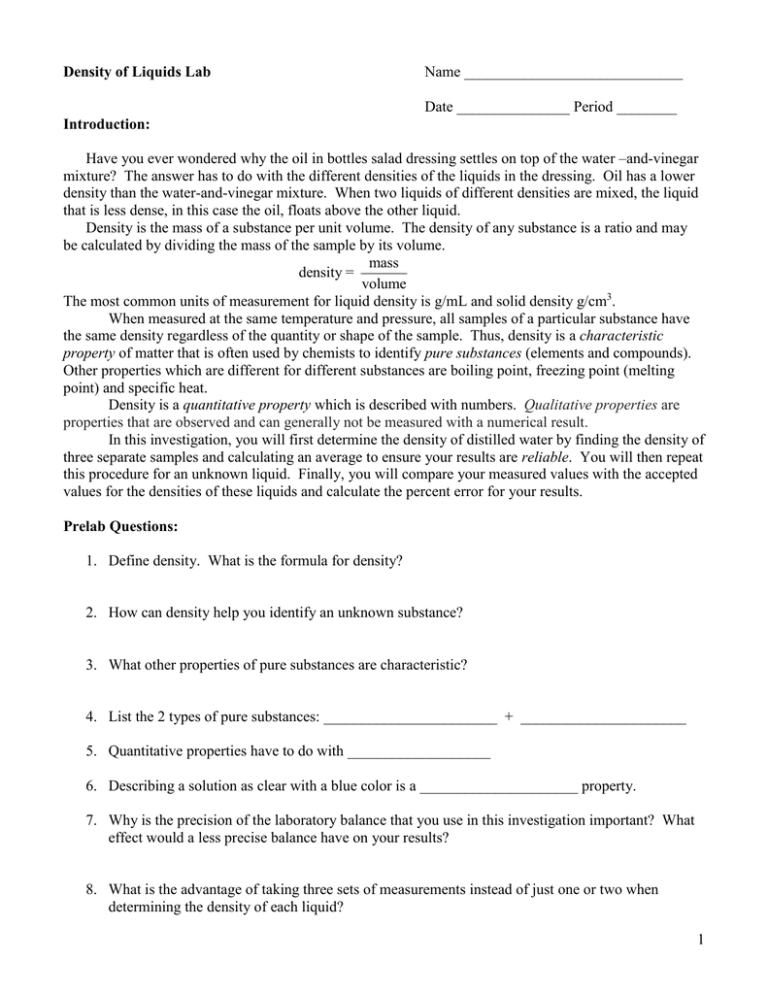Name _____________________________ Date _______________ Period ________
advertisement

Density of Liquids Lab Name _____________________________ Date _______________ Period ________ Introduction: Have you ever wondered why the oil in bottles salad dressing settles on top of the water –and-vinegar mixture? The answer has to do with the different densities of the liquids in the dressing. Oil has a lower density than the water-and-vinegar mixture. When two liquids of different densities are mixed, the liquid that is less dense, in this case the oil, floats above the other liquid. Density is the mass of a substance per unit volume. The density of any substance is a ratio and may be calculated by dividing the mass of the sample by its volume. mass density = volume The most common units of measurement for liquid density is g/mL and solid density g/cm3. When measured at the same temperature and pressure, all samples of a particular substance have the same density regardless of the quantity or shape of the sample. Thus, density is a characteristic property of matter that is often used by chemists to identify pure substances (elements and compounds). Other properties which are different for different substances are boiling point, freezing point (melting point) and specific heat. Density is a quantitative property which is described with numbers. Qualitative properties are properties that are observed and can generally not be measured with a numerical result. In this investigation, you will first determine the density of distilled water by finding the density of three separate samples and calculating an average to ensure your results are reliable. You will then repeat this procedure for an unknown liquid. Finally, you will compare your measured values with the accepted values for the densities of these liquids and calculate the percent error for your results. Prelab Questions: 1. Define density. What is the formula for density? 2. How can density help you identify an unknown substance? 3. What other properties of pure substances are characteristic? 4. List the 2 types of pure substances: _______________________ + ______________________ 5. Quantitative properties have to do with ___________________ 6. Describing a solution as clear with a blue color is a _____________________ property. 7. Why is the precision of the laboratory balance that you use in this investigation important? What effect would a less precise balance have on your results? 8. What is the advantage of taking three sets of measurements instead of just one or two when determining the density of each liquid? 1 9. Why should you avoid skin contact with the unknown solution? 10. Do you expect your measured values for the density of water and the unknown to differ from the accepted values? See page 3 data table to explain your answer. Materials: balance 10 mL graduated cylinder Procedure: Density of Water unknown liquid acetone 1. Mass an empty, clean, dry 10-mL graduated cylinder to the correct number of places and record data in Table 1. This value may be used for all trials. 2. Fill the graduated cylinder with 9-10 mL of distilled water and mass it again. Record in Table 1. 3. Read the volume of the water precisely. Remember to read at the bottom of the meniscus and to the correct number of places. Record data in Table 1. 4. Repeat steps #1-3 with 2 lesser volumes of water. Do not go below 5 mL. 5. Empty the graduated cylinder and dry with 1-2 mL of acetone as shown and go on to step #6. Density of Unknown 6. Write the same mass of the empty, clean and dry 10-mL graduated cylinder in Table 2. 7. Repeat steps #2-5 with your unknown liquid. Remember to record the liquid # in Table 2. 8. Wash graduated cylinder well with SOAP and RINSE well. Do not dry. Return to drawer. Data: TABLE 1: Water Trial 1 Trial 2 Trial 3 mass of graduated cylinder and water (g) mass of empty graduated cylinder (g) mass of water (g) volume of water (mL) density of water (g/mL) 2 TABLE 2: Unknown # ________ Trial 1 Trial 2 Trial 3 mass of graduated cylinder and unknown (g) mass of empty graduated cylinder (g) mass of unknown (g) volume of unknown (mL) density of unknown (g/mL) Calculations: 1. Calculate the mass, volume and density of the water and unknown and write in the data table. 2. Determine the average density of water: 3. Determine the average density of the unknown: Questions: 1. Based on your data, which of the liquids in the table below could be your unknown? ________________________________________ TABLE 3: Accepted Values for Density & Boiling Point of Various Liquids LIQUID ethanol isopropyl alcohol methanol mineral oil water ethylene glycol glycerine DENSITY (g/mL) at 20C 0.789 0.786 0.791 0.830 0.998 1.114 1.261 Boiling Point (ºC) at 1atm 78.4 82.6 64.7 310.0 100.0 197.3 290.0 3 2. Using the formula below, calculate the percent error for the average density of water and your unknown liquid. percent error measured value - accepted value x 100% accepted value Percent error for water = Percent error for unknown = 3. What changes could you make in the procedure to increase the accuracy of your results? The precision? 4. If your unknown had a density of 0.79 g/mL and you knew that it was one of the three substances listed in the Table 3 having a density close to that value, how would you determine which liquid was your unknown? Explain using values from Table 3 5. Ice floats on water. Is ice more or less dense than water? ________________How do you think the density of ice affects the survival of water-dwelling organisms in environments where temperatures fall below the freezing point? 6. When stating density of a liquid, why is it necessary to state the temperature? 4




